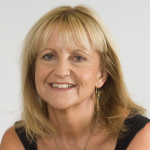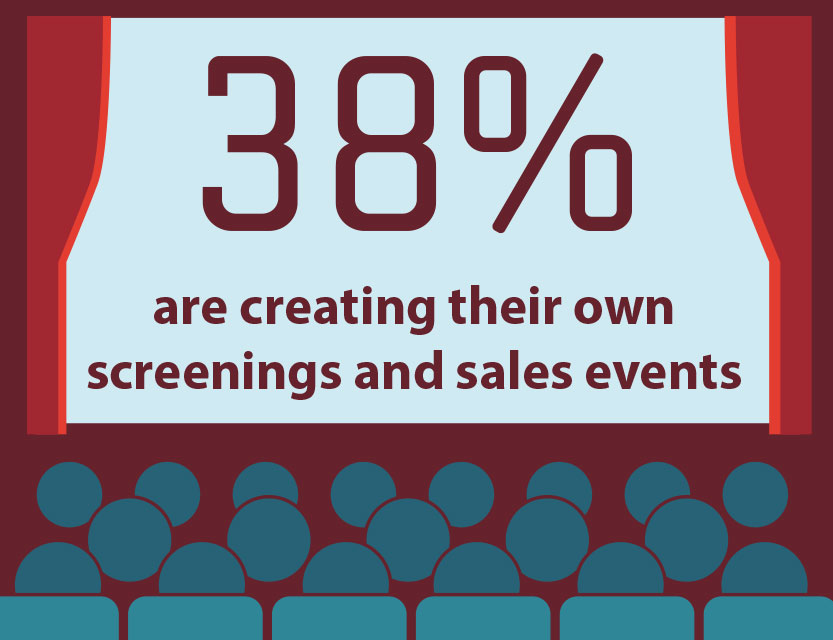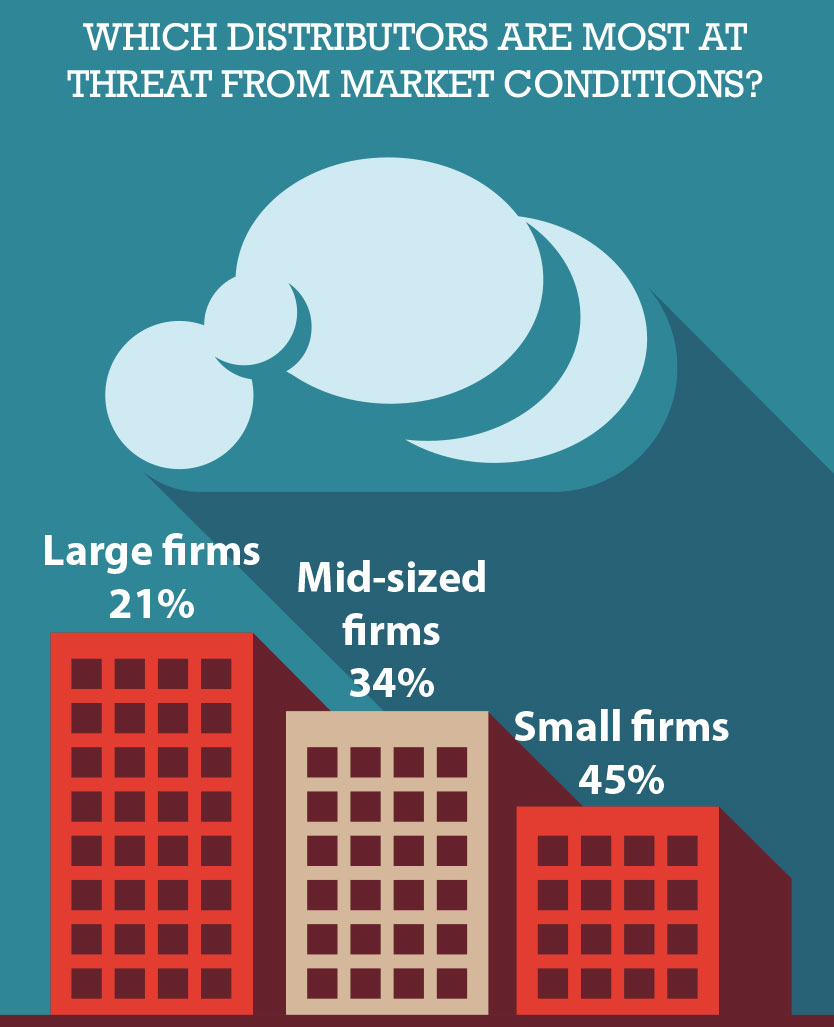
After more than 35 years of operation, TBI is closing its doors and our website will no longer be updated daily. Thank you for all of your support.
TBI Distributors Survey 2017 – Part 3

 The third part of our industry-wide survey considers the shape of the market, and how continued consolidation has affected the business. We also reveal which markets remain vital to distribution strategies and uncover how companies are holding their own screenings events and get-togethers to entice the buyers.
The third part of our industry-wide survey considers the shape of the market, and how continued consolidation has affected the business. We also reveal which markets remain vital to distribution strategies and uncover how companies are holding their own screenings events and get-togethers to entice the buyers.
CONSOLIDATORS
The period we have surveyed (February 2016-August 2017) saw little in the way of major distributor consolidation. The previous year had seen the formation of the Endemol Shine Group and a deal to bring Zodiak Media Group and Banijay Group together. However, 83% still expect more market consolidation in the 2017/18 period.
A consolidated market sees fewer, but bigger players competing for content. However, boutique distributors claim it actually helps smaller businesses.
“Market consolidation creates positive outcomes for smaller niche businesses,” says Dominic Saville, CEO of factual-focused 3DD.
“You have to define your area of strength. As with any industry, if your content or IP is strong then you will have a good market share regardless of supermarket growth or consolidation. The goals are different for each: Market dominance verses content value.”
Many pointed to a belief that the sitting in the middle of the market (classed as a company of 20-50 employees) puts distributors most at risk.
“Smaller distributors have lower operating costs and can be nimble and diversify, while large distributors usually have the support of a broadcaster as a funder, and/or have many output deals,” says David Hooper, founder of Espresso Media International. “However, mid-sized companies have neither the qualities of either and can be therefore very prone to cashflow issues.”
 Similarly, according to Lucas Bertrand of MoMedia (right), “The cost structures of medium-sized players make it difficult to compete with larger players and more nimble and low-cost smaller players. Mid-size players really need some hits to carry them through and avoid financing issues.” Quintus Media’s Gerrit Kemming adds: “The small ones are able to cooperate with the big ones. The mid size drowns.”
Similarly, according to Lucas Bertrand of MoMedia (right), “The cost structures of medium-sized players make it difficult to compete with larger players and more nimble and low-cost smaller players. Mid-size players really need some hits to carry them through and avoid financing issues.” Quintus Media’s Gerrit Kemming adds: “The small ones are able to cooperate with the big ones. The mid size drowns.”
Cathy Payne (below right), whose Endemol Shine International has one of the largest catalogues on the market, says: “Distribution is about the big and boutique, and no one wants to be in the middle ground where it is hard to compete. For a distributor to grow without any guaranteed product flow from in-house production companies is challenging.”
Indeed, having associated prodcos can allow a distributor to bypass the rights fight and get their hands on content with much less risk. Among those polled, 61% are lucky enough to have production cousins in their stable, with the rest more reliant on third-party acquisitions.
Cineflix’s Bonney offers a mid-market defence. “A minimum critical mass is required to manage the increasingly complex rights environment, to secure new content through deficit financing, and to have the necessary leverage with key global buyers such as Discovery and Netflix.”
Despite all these threats to the middle ground, a majority believe small firms are most at risk from market conditions. A.P. Catarino from Brazil’s Oca Animation says this is simply because “smaller means weaker”.
Keshet’s Keren Shahar says: “It will become harder for small distributors to compete with the resources the large ones have to invest in content.”
 “It’s important to be able to support shows with a substantial budget, and be able to mitigate risk by having the opportunity to invest in a large portfolio of shows,” says Entertainment One’s Stuart Baxter. “Smaller firms have less ability to resist and stand up to the big SVOD players.”
“It’s important to be able to support shows with a substantial budget, and be able to mitigate risk by having the opportunity to invest in a large portfolio of shows,” says Entertainment One’s Stuart Baxter. “Smaller firms have less ability to resist and stand up to the big SVOD players.”
“Any distributor, from the smallest to largest, is at risk if they’re not evolving to look beyond pure distribution, which is increasingly becoming a margin-challenged environment,” says BBC Worldwide’s Paul Dempsey.
Tim Hegarty at the ACTF has a slightly different view. While he agrees all are threatened in different way, “The large distributors are arguably the most at risk if there’s a downturn in the industry, purely because of the overheads involved”.
John Kramer, CEO of LA’s Rive Gauche Television, has a warning for all businesses. “All firms are at risk,” he says. “Look at all the big mergers. Was that because all those companies were healthy?”
OFF TO MARKET
Results from our survey show just how important October’s MIPCOM remains to the international TV market, with a whooping 97.2% saying it is a must-attend market. This is up from 75.8% in 2016.
Interestingly, though many sources privately claim the need to attend the other Cannes market, MIPTV, is diminishing, there was slight year-on-year growth in favour of the event, up from 61.3% a year ago to 64.8%.
Few contributors say the need for face time with clients is any less important than in the past, and it will be interesting to see how the full launch of TRX’s digital distribution platform affects the nature of dealmaking. For their part, the TRX chiefs have always positioned the innovative interface as a complement to markets, not a replacement.
“There’s no substitute for the quality time that comes from face-to-face meetings with both broadcast and producer clients, and these markets produce a cost-efficient way to achieve this,” says Cineflix’s Bonney.
“MIPCOM remains a strong launch pad for Passion’s portfolio for the following twelve months,” says the Tinopolis-owned company’s Emmanuelle Namiech.
“MIPTV still works well for us, but its importance wanes as fewer buyers attend. Regional markets such as NATPE and Discop work well for us,” one exec says.
 Among the regional markets, NATPE Miami and the Asia Television Forum are both considered important, with the LA Screenings and Berlin International Film Festival also bringing in plenty of traffic.
Among the regional markets, NATPE Miami and the Asia Television Forum are both considered important, with the LA Screenings and Berlin International Film Festival also bringing in plenty of traffic.
Among the thematic events Kidscreen and Realscreen are the big markets, while the other noticeable trend is the number of companies launching their own screenings, with sales now considered a much more year-round process than the more cyclical nature of the past.
“We stage an annual Formats Festival in February, while we also hold drama screenings for buyers,” says ITV Studios Global Entertainment managing director Ruth Berry (above right).
“With our footprint of global offices, most of our discussions with buyers take place through out the year on an on-going basis, regardless of global events,” says Luci Sanan, formats director at The Story Lab. “We do arrange events during the year for local and global market buyers to attend.”
 Henrik Pabst (left), managing director of Germany’s Red Arrow International, makes the most of the company’s local surroundings to a bid to entertain and entice acquisition execs.
Henrik Pabst (left), managing director of Germany’s Red Arrow International, makes the most of the company’s local surroundings to a bid to entertain and entice acquisition execs.
“We invite selected buyers to our annual Oktoberfest screenings, and run roadshows and territory-specific screenings and events throughout the year,” he says.
Laurent Boissel of About Premium Content says his firm is holding “more screenings at new festivals”, which ties in with the interest in Berlin and the Cannes Film Festival.
MIPTV organiser Reed MIDEM is hoping to tap into that trend with the launch of Cannes Series, the international drama series screening event that the city of Cannes is working with the events company to create, alongside investor Canal+.




